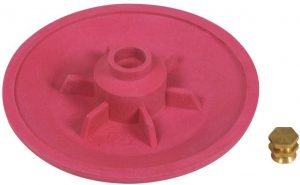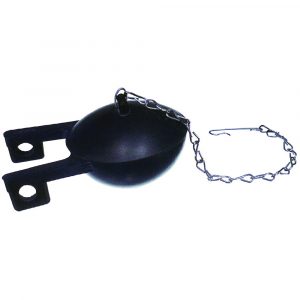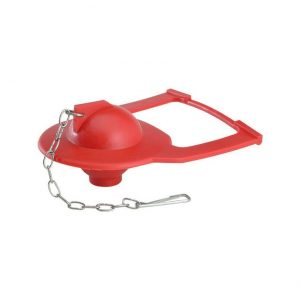My Best Toilet is reader-supported. When you buy through links on our site, we may earn an affiliate commission from Amazon at no added cost to you.
Toilet flappers are the most common cause of leaking or running toilets because they seal the flush valve and limit the amount of water released into the bowl.
It is critical to install the correct toilet flapper since it will assist avoid leaks in your bathroom. If you install an inappropriate or ill-fitting toilet flapper, your toilet will not only leak and waste water, but it will also cost you money.
When visiting a home improvement store, you will be confronted with a bewildering array of toilet flappers, so it is critical that you understand how to select the correct one. If you install the incorrect toilet flapper, your toilet may not flush properly and may use more water than it is supposed to.
Here in this article, I’ll explain various types of toilet flappers and how you can replace them.
What is a Toilet Flapper?
The toilet flapper is a rubber seal that closes the flush valve to keep the water in the tank and opens it when the handle lever is pulled. It is the toilet component that drains water from the tank to the bowl when the toilet is flushed. Toilet flappers vary in design and model, just as toilets do.
When there is water in the toilet tank, the flapper is designed to remain sealed until the toilet is flushed. The flapper is connected to the tank lever by a chain. When pressed, this lever pulls the chain and lifts the flapper, allowing water to enter the bowl.
When the toilet tank is full, an air ball floats on the flapper. When the tank is completely empty (flushed), the same flapper ball cannot float and is responsible for closing the flush valve.
Types of Toilet Flappers
Toilet flappers are classified into three types: seat disk, tank ball, and rubber. You can simply remove the top of your toilet tank and inspect it to determine what sort of toilet flapper you have.
Seat Disk Flapper

Seat disk toilet flappers are the most traditional type of toilet flapper. These are distinguished by a little round disk at the tank’s base that covers the overflow pipe, preventing water from flowing through it. When you flush the toilet, the flapper exposes the overflow pipe.
When you flush, a reservoir of water acts as a weight to keep the flapper open. The reservoir, on the other hand, empties when flushed. As a result, after a specific amount of time, the flapper will close.
Seat disk flappers do have some drawbacks. These flappers can be rather huge and take up a lot of room in your toilet tank. This not only makes it more difficult to replace but also makes finding a replacement choice even more complicated.
Tank Ball Flapper

Although they are not strictly a type of toilet flapper, they accomplish the same functions. In older toilets, tank balls are more common.
The tank ball flapper rests on top of the overflow pipe in these toilets. When the toilet is flushed, a chain lifts the rubber ball straight up and away from the overflow pipe. Water is able to flow into the toilet bowl through the flush valve as a result of this.
If you have a tank ball flapper, make sure the chain that holds the ball is the correct length. If it is not, it will either fail to lift the ball or prevent it from returning to its original position. As a result, the toilet may not seal properly, wasting a lot of water.
Another drawback is that a tank ball flapper will deteriorate and lose shape over time. This indicates that the tank ball will not sufficiently seal the flush valve to prevent water from spilling down into the toilet.
Rubber Flapper

The most common type of toilet flapper in newly constructed toilets is a rubber flapper. These flappers function by connecting an overflow pipe to a simple cap. When you flush the toilet, a chain lifts the flapper, allowing water to pass through the flush valve, similar to the tank ball flapper. When the flushing is finished, the chain permits the cap to return to its original position.
The word “rubber” may be misleading, as not all flappers of this type are entirely constructed of rubber. Some of these flappers are entirely made of rubber or silicone and are extremely flexible; others are made of hard plastic but have a rubber or silicone seal on the bottom. To seal tightly against the overflow pipe, these flappers may just have a rubber outside edge.
As previously stated, rubber flapper types are the most popular because they are reliable and widely available on the market. They do, however, have a comparable drawback to tank ball flappers. If the chain is not the correct length, the flapper will not allow the correct amount of water into and out of the tank, perhaps resulting in leaks.
Things to know before Buying A Toilet Flapper
Size of Toilet Flapper
There is no standard flapper size. Flappers are typically two or three inches in length. Two-inch flappers were more common in the past. However, three-inch flappers have recently entered the market.
Most toilets differ in shape, size, and design. You can measure the size of their flush valve systems to determine the correct size to select. Looking at the flush valve draining at the bottom of your toilet tank is the best way to determine the flapper size you require., and there is.
Durability of a Toilet Flapper
A toilet flapper can last for about five years on average. However, if you use harsh chemical bowl cleaners, corrosion will occur, necessitating regular flapper replacement. As a result, you must exercise caution when using cleaners.
Replacement of Toilet Flappers: When and How
Your toilet flapper will send you some warning signals just before it fails. They are unable to properly flush your toilet. When flushing, strange noises coming from the toilet; your toilet continues to run without stopping and there are leaks.
Replacing a toilet flapper is no big deal. Follow a few simple steps and you can do it easily in no time.
- Obviously, you need to turn off the water first so that water doesn’t flood in when you try to tamper with the flapper.
- Now you can remove the old flapper without any hassle.
- Once the flapper is removed you can prepare and install the new flapper.
There could be a few reasons why your flapper needs to be replaced more frequently than it should. It could be because of hard water or the use of harsh cleaners. Furthermore, you may have installed the incorrect flapper type/size for your toilet.
Why do you need to replace your Toilet Flappers?
Most homeowners never give the toilet flapper much thought, but this inexpensive and unassuming component is actually one of the most important in your bathroom. It not only prevents toilet leaks but also ensures that you do not have to flush more than once per visit.
Still, flappers will fail eventually, and when they do, it is critical to replace them. Here are some reasons why flappers deteriorate and need replacement
Flappers have an expiry date
Both the flap and the floating arm are made of a flexible material, typically rubber or plastic. This material will break or simply wear out over time as a result of repeated use.
It’s also worth noting that flappers have been known to develop leaks in as little as five years. While this is not typical, it does occur.
In fact, some manufacturers have stated explicitly that they expect their flappers to last no more than five years. Simply looking at the age of your old flapper will help you determine whether or not it is time to replace it.
If the toilet has been installed for more than five years, it may be time to replace it.
Mold, Mildew, Bacteria
Toilet flappers can fail as a result of mildew, mold, or bacteria growth. The growth of these microorganisms can cause the flapper to break or simply no longer fit snugly around the flush valve.
Because it is difficult to avoid this problem, flappers will need to be changed every five years or so.
Excess use of Corrosive Acids
Toilet flappers can corrode if corrosive toxins and tablets are introduced to the tank. This is due to the fact that the chemicals can react with the plastic or rubber material, starting to cause it to degrade.
If you think this has happened to your toilet, there is a simple test to determine whether or not the flapper is faulty. Slowly pour some colored dye into the tank and let it sit for a few minutes.
If the water in the toilet bowl turns the color of the dye, it means the flapper is faulty and is not sealing the flush valve.
Bottom Line
Before buying a new flapper, it is usually a good idea to know the make and model of your toilet. In most circumstances, using OEM components is the best method to solve the problem correctly the first time. Knowing what kind of toilet flapper you have can help you choose the right one at the hardware store.
Installing an incompatible toilet flapper may aggravate the situation. Hope the guide helps you choose the right toilet flapper for your toilet.
Amazon and the Amazon logo are trademarks of Amazon.com, Inc, or its affiliates.


